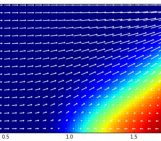
Guest contribution from Daniel Kretschmer, University of Potsdam
European groundwater quality is deteriorated by seawater intrusion, the displacement of freshwater by a landward movement of seawater (Custodio, 2010). Just south of Barcelona, the deep confined aquifer at the Llobregat river delta has experienced SWI of several kilometers due to intensive groundwater abstraction in the 20th century (Custodio, 2010). Before excessive pumping, groundwater salinity in the Llobregat’s delta aquifer was naturally limited due to the aquifer’s hydraulic head, hydraulic conductivity, and groundwater flow towards the ocean (Custodio, 2010; Werner et al., 2013). But due to high abstraction rates, the hydraulic heads around the wells dropped. In the Llobregat case, the high abstraction rates were balanced by a landward flow of seawater (Custodio 2010). The intrusion contaminated pumping wells thousands of meters inland (Post, 2018).
The exploitation of coastal groundwater has led to salinization of many coastal aquifers worldwide (Cao et al., 2021). A large fraction of reported SWI worldwide is located in highly populated regions that rely on pumping groundwater and concrete-heavy construction (Cao et al., 2021). Affected regions experience a pattern like in the Llobregat case: excessive coastal groundwater pumping causes a landward shift of the mixing zone between saltwater and freshwater. This shift balances the drop in hydraulic head at the well and fills formerly fresh parts of the aquifer with salty water. Moreover, pumping fresh water in proximity to saline water can cause upconing, an upward motion of saltwater into the well, contaminating the pumped water (Fig.2, Post et al., 2018; Werner et al., 2013). Besides pumping, there are other anthropogenic actions that intensify SWI: river dams upstream, drainage of wetlands (causing land subsidence and overwash risk), and the construction of impervious surfaces (reducing recharge of groundwater) (Fig.2; Post et al., 2018).

Seawater intrusion may occur due to reduced groundwater recharge or upconing due to groundwater abstraction (based on literature, e.g., Werner et al., 2013, Post et al., 2018)
While a large fraction of observed SWI is induced by humans, it is occurring naturally, too. In the short term, storms flooding coastal areas can temporarily increase shallow coastal groundwater salinity (Post et al., 2018). On longer time scales, seasonal and persistently rising mean sea levels can cause saline groundwater to intrude into coastal aquifers: A 1 m rise of mean sea levels may induce SWI exceeding several kilometers, depending on aquifer properties (Michael et al., 2013).
About 40% of the global population lives within 100 km of the coast (UN, 2017), and the coastal population is expected to grow quickly. To ensure the availability of water for all (Sustainable Development Goal 6), mitigation of seawater intrusion will be crucial. For effective SWI mitigation, it is critical to intervene before tipping points related to sea level rise, groundwater discharge or hydraulic head are passed (Mazi et al., 2013). The time to act is now, and since only 1% of seawater mixed into fresh water can make it unsuitable for human consumption (Post et al., 2018), there is low margin for error.
Cao et al., 2021: 10.1016/j.jhydrol.2021.126844
Custodio, 2010: 10.1007/s10040-009-0496-1
Mazi et al., 2013: 10.1088/1748-9326/8/1/014001
Michael et al., 2013: 10.1002/wrcr.20213
Post et al., 2018: Groundwater management in coastal zones
UN, 2017: Factsheet: People and Oceans
Werner et al., 2013: 10.1016/j.advwatres.2012.03.004




